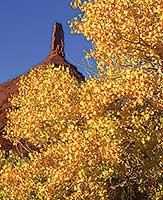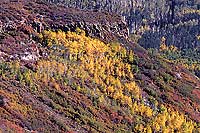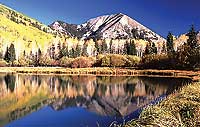The autumn season in Canyon Country is marked by changing temperatures, shortened days, and the sometimes-subtle transition of leaves to their fall colors. These weather-dependent foliage changes may be prolonged through October, adding more beauty to an already colorful landscape.
Most deciduous shrubs and trees lose their leaves in the fall. These plants have adapted to dropping their leaves in the fall and shutting down the photosynthetic pathway for winter. During this transition, the green chlorophyll pigments in the leaves break down and unmask other pigments that turn the leaves yellow or red. These pigments are slower to breakdown than the chlorophyll, thus the colorful leaves remain on the plant for a while. As the leaves change and age, an abscission zone forms near the base of the leaf’s stem, eventually severing the leaf and causing it to fall away.
In the canyons, look for Fremont’s cottonwoods lining the drainages. Bearing shimmering golden leaves these hardy trees may hold their color long past Halloween. But when the temperatures drop, so do the leaves – at times in a cascade of shedding. The cottonwoods slumber through the winter, their furrowed bark and gnarled limbs exposed to the elements.
Willows, netleaf hackberry, and single-leaf ash grow alongside or nearby to the cottonwoods and may also lose their leaves after they turn a light yellow. Sometimes the withered leaves remain attached, unwilling to let go and litter the canyon floor. Many Canyon Country residents suffer this same fate, giving up fall for the icy chill of winter is a reluctant proposition.

In the mountain foothills there is a brushy habitat layer that extends above the pinyon-juniper woodlands. The shrubs in this mountain-brush habitat may form a mosaic of colors, randomly splashed across the landscape. Mountain mahogany, wild rose, serviceberry, three-leaved sumac, and Gambel’s oak dominate this colorful palette. These deciduous shrubs mix with sagebrush, bitterbrush, and grasses creating a kaleidoscope of colors in its prime. The oaks may hold some of the brown leaves through winter, while sagebrush and bitterbrush leaves that remain on the branches may be eaten by mule deer, elk, and other creatures.
 Higher up in the mountains, vast swaths or narrow stringers of aspen trees explode in gold. “There’s gold up in them thar’ hills” may refer to gold minerals the miners found years ago, but it is also an appropriate expression to describe this spectacular sight. A rare find would be a red aspen leaf set against this golden canvas.
Higher up in the mountains, vast swaths or narrow stringers of aspen trees explode in gold. “There’s gold up in them thar’ hills” may refer to gold minerals the miners found years ago, but it is also an appropriate expression to describe this spectacular sight. A rare find would be a red aspen leaf set against this golden canvas.
In addition to the changing leaves, a few late wildflowers may also add color to the land. Rabbitbrush, also known as chamissa, and snakeweed are a couple of different Sunflower family plants that bloom well into fall. Bearing yellow flowers, these shrubs form a “ground cloud” of gold and attract late-season pollinators such as butterflies or beetles before the killing frost dooms these creatures.
Throughout the fall, burnt-sienna cliffs and turquoise hills form the backdrop to this colorful leafy progression. Like the autumn leaves, occasionally a cliff edge exfoliates or an arch loses its strength and collapses into a pile of rubble. These transitions may occur during autumn, a time of constant and colorful change.



 Higher up in the mountains, vast swaths or narrow stringers of aspen trees explode in gold. “There’s gold up in them thar’ hills” may refer to gold minerals the miners found years ago, but it is also an appropriate expression to describe this spectacular sight. A rare find would be a red aspen leaf set against this golden canvas.
Higher up in the mountains, vast swaths or narrow stringers of aspen trees explode in gold. “There’s gold up in them thar’ hills” may refer to gold minerals the miners found years ago, but it is also an appropriate expression to describe this spectacular sight. A rare find would be a red aspen leaf set against this golden canvas.